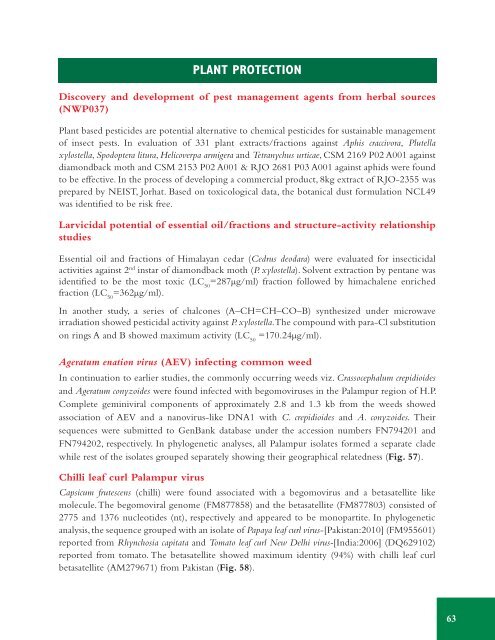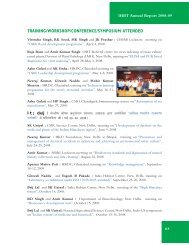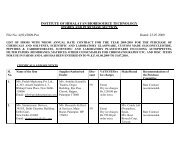You also want an ePaper? Increase the reach of your titles
YUMPU automatically turns print PDFs into web optimized ePapers that Google loves.
PLANT PROTECTIONDiscovery and development of pest management agents from herbal sources(NWP037)Plant based pesticides are potential alternative to chemical pesticides for sustainable managementof insect pests. In evaluation of 331 plant extracts/fractions against Aphis craccivora, Plutellaxylostella, Spodoptera litura, Helicoverpa armigera and Tetranychus urticae, CSM 2169 P02 A001 againstdiamondback moth and CSM 2153 P02 A001 & RJO 2681 P03 A001 against aphids were foundto be effective. In the process of developing a commercial product, 8kg extract of RJO-2355 wasprepared by NEIST, Jorhat. Based on toxicological data, the botanical dust formulation NCL49was identified to be risk free.Larvicidal potential of essential oil/fractions and structure-activity relationshipstudiesEssential oil and fractions of Himalayan cedar (Cedrus deodara) were evaluated for insecticidalactivities against 2 nd instar of diamondback moth (P. xylostella). Solvent extraction by pentane wasidentified to be the most toxic (LC 50=287μg/ml) fraction followed by himachalene enrichedfraction (LC 50=362μg/ml).In another study, a series of chalcones (A–CH=CH–CO–B) synthesized under microwaveirradiation showed pesticidal activity against P. xylostella. The compound with para-Cl substitutionon rings A and B showed maximum activity (LC 50=170.24µg/ml).Ageratum enation virus (AEV) infecting common weedIn continuation to earlier studies, the commonly occurring weeds viz. Crassocephalum crepidioidesand Ageratum conyzoides were found infected with begomoviruses in the Palampur region of H.P.Complete geminiviral components of approximately 2.8 and 1.3 kb from the weeds showedassociation of AEV and a nanovirus-like DNA1 with C. crepidioides and A. conyzoides. Theirsequences were submitted to GenBank database under the accession numbers FN794201 andFN794202, respectively. In phylogenetic analyses, all Palampur isolates formed a separate cladewhile rest of the isolates grouped separately showing their geographical relatedness (Fig. 57).Chilli leaf curl Palampur virusCapsicum frutescens (chilli) were found associated with a begomovirus and a betasatellite likemolecule. The begomoviral genome (FM877858) and the betasatellite (FM877803) consisted of2775 and 1376 nucleotides (nt), respectively and appeared to be monopartite. In phylogeneticanalysis, the sequence grouped with an isolate of Papaya leaf curl virus-[Pakistan:2010] (FM955601)reported from Rhynchosia capitata and Tomato leaf curl New Delhi virus-[India:2006] (DQ629102)reported from tomato. The betasatellite showed maximum identity (94%) with chilli leaf curlbetasatellite (AM279671) from Pakistan (Fig. 58).63




